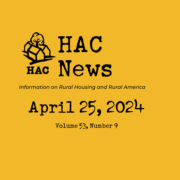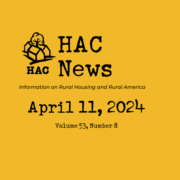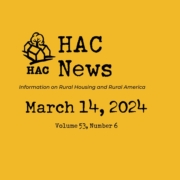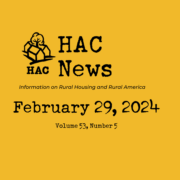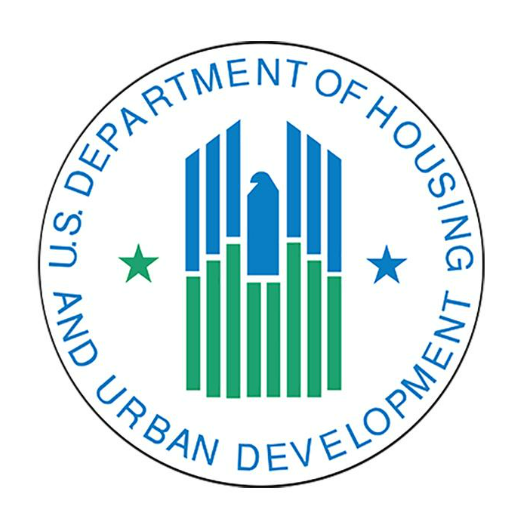HAC News: April 25, 2024
TOP STORIES
Agencies update energy efficiency standards
Some federally supported new housing construction, including single-family homes supported by USDA’s Section 502 direct, Section 502 guaranteed, or Section 523 self-help programs, will be required to meet updated energy efficiency standards under a determination announced by HUD and USDA on April 25. In recognition of challenges they may face in implementing the changes, rural persistent poverty rural areas have a 24-month compliance period rather than the shorter timeframes for other places; USDA will publish a map identifying where the longer compliance period applies. HAC and a coalition of other organizations welcomed the changes. After the agencies proposed them last year, a comment letter circulated by HAC and signed by more than 80 other organizations supported the updated standards because they will reduce homebuyers’ utility bills. The letter also suggested ways to cover the upfront costs of building to higher standards.
RuralSTAT
A little over 60% of homes nationwide are single-family detached dwellings, but in rural America they comprise over 72% of homes. Structures with two or more units make up a smaller part of the rural housing stock at 12.2% collectively – less than half the national level of multi-unit structures at 26.3%. Source: HAC tabulations of the U.S. Census Bureau’s 2017-2021 American Housing Survey.
OPPORTUNITIES
USDA offers farmworker housing funds
Section 514/516 loans and grants are available to develop off-farm housing for farmworkers. Nonprofit organizations, Tribes, state or local governments, and limited partnerships with nonprofit general partners are eligible. Preapplications are due July 3. USDA also recently announced a June 18 deadline for subsequent loans and grants to improve, repair, or modify properties that already have Section 514 or 516 funding. For more information on either announcement, contact Jonathan Bell, USDA, MFHprocessing1@usda.gov, 202-205-9217.
Disaster repair grants available for homeowners
USDA offers Section 504 Rural Disaster Home Repair Grants for low-income owners of homes damaged by 2022 presidentially declared disasters. The program requirements, including those for homeowners’ age and income level, are not the same as those of the regular Section 504 program. Applications will be accepted as long as funds remain available. For more information, contact a local USDA RD office.
Creative placemaking grant competition opens
Our Town or Nuestra Ciudad, the creative placemaking grants program of the National Endowment for the Arts, offers grants from $25,000 to $150,000 with a 1:1 match requirement. The program supports activities that integrate arts, culture, and design into local efforts to advance local economic, physical, or social outcomes. These projects require a partnership between a nonprofit organization and a local government entity, with one of them or a third partner being a cultural organization. The first part of the application is due August 1. For more information, contact NEA staff, OT@arts.gov.
Water systems grants will finance revolving funds
USDA’s Rural Decentralized Water Systems Grant Program makes grants to nonprofits to establish and maintain revolving funds that provide loans and sub-grants to low- and moderate-income individuals for individually owned water well systems and/or individually owned wastewater systems. Eligible areas include rural areas and towns with populations of 50,000 or less, Tribal lands in rural areas, and colonias. Apply by June 28. For more information, contact Lola Maratita, USDA, Dolores.Maratita@usda.gov, 615-714-8883.
Racial equity committee at Treasury seeks members
The deadline for nominations to the Treasury Advisory Committee on Racial Equity has been extended to May 20. The U.S. Treasury Department administers the Community Development Financial Institutions programs and a number of Inflation Reduction Act and pandemic recovery programs. For more information, contact Rhianna Rogers, Treasury, equity@treasury.gov, 202-622-3644.
REGULATIONS AND FEDERAL AGENCIES
OCC extends comment period on bank merger
The Office of the Comptroller of the Currency has extended the time to submit public comments on the proposed application by Capital One to acquire Discover Bank. Comments may now be submitted through May 31.
HUD revises rule on floodplains and wetlands
A new final rule amends HUD’s regulations governing floodplain management and the protection of wetlands to implement the Federal Flood Risk Management Standard, and revises HUD’s Minimum Property Standards. HUD will publish guidance on compliance and will schedule two webinars on the final rule. To receive future announcements, subscribe to HUD’s Office of Housing email list.
Multifamily insurance deductibles rise for wind and storm coverage
The Federal Housing Administration is changing its requirements for wind and named storm insurance coverage at multifamily properties with FHA mortgage insurance. FHA is increasing the maximum allowable deductibles, so insurance policies will cost property owners less. HUD explains the changes in guidance documents here and here.
EVENTS
USDA to hold tenants’ rights roundtable online
USDA Rural Development will host a community roundtable on Thursday, May 2 to review the rights and protections for tenants of USDA-financed properties. Participants will be able to provide feedback and discuss additional ways USDA can support their needs. Register here.
Webinar series will advise on equitable energy efficiency programs
On May 21, Navigating Organizational Funding for Home Energy Upgrade Programs in Justice 40 Communities will cover the nuts and bolts of applying for Inflation Reduction Act and Bipartisan Infrastructure Law grants, prizes, and technical assistance. This is the first workshop in a series organized by EPA and the American Council for an Energy-Efficient Economy, designed to support community-based organizations, small businesses, and local governments in creating equitable efficiency and electrification home upgrade programs.
Listening sessions will cover HUD’s environmental justice plan
HUD will hold three listening sessions online as it develops a 2024-2028 Environmental Justice Strategic Plan. During these events, HUD officials will offer information about the development of the Strategic Plan and external stakeholders can provide feedback on priorities HUD should consider and concerns related to environmental justice in communities with HUD-assisted housing. Register here for public sessions on May 1 or May 2. Register here for an April 30 session specifically for Tribes, Tribally Designated Housing Entities, and Tribal Housing Authorities.
PUBLICATIONS AND MEDIA
Federal Reserve asks for responses to 2024 Community Perspectives Survey
The Federal Reserve System invites organizations that serve low- to moderate-income communities to take its Community Perspectives Survey. The survey collects insights on the economic conditions of low- to moderate-income communities and the health of the organizations serving them. It is open through April 30.
Toolkit advises working on data with people with lived experience of homelessness
People with Lived Experience and Expertise of Homelessness and Data Decision-Making is a HUD toolkit highlighting the importance of ensuring people with lived experiences are partners for decision making efforts by Continuums of Care and community partners. It includes resources on partnership practices, compensation, and training.
Artificial intelligence’s use in housing industry examined
Housing Industry Innovation: 5 Ways AI Can Help Boost Supply and Affordability, a brief from the Bipartisan Policy Center, summarizes ways AI is changing five areas related to housing: predevelopment, construction, creditworthiness, home appraisals, and property tax assessments. It includes a link to an AI 101 brief as well as links to more detailed information about the topics covered.
Study addresses barriers to federal funding for rural places
The West Virginia Community Development Hub’s Barriers to Federal Investment in Rural Communities report uses West Virginia as a case study to examine key factors that prevent rural, coal-impacted communities from effectively competing for federal funding across multiple agencies. The authors then identify simple strategies that federal agencies can implement to address these barriers.
Montana housing discussed in podcast
A Pew Trusts podcast episode, Housing in America: A Foundation in Montana, covers housing affordability issues. Montana state lawmakers describe legislation to address the concerns and Indigenous advocates discuss Tribal housing solutions.
HAC
HAC is hiring
HAC job listings, each with application instructions, are available on our website.
- Loan Asset Management Intern
- Senior Loan Officer
- Portfolio Management Associate
- Research Associate
- Research Assistant
Need capital for your affordable housing project?
HAC’s loan fund provides low interest rate loans to support single- and multifamily affordable housing projects for low-income rural residents throughout the U.S. and territories. Capital is available for all types of affordable and mixed-income housing projects, including preservation, new development, farmworker, senior and veteran housing. HAC loan funds can be used for pre-development, site acquisition, site development, construction/rehabilitation and permanent financing. Contact HAC’s loan fund staff at hacloanfund@ruralhome.org, 202-842-8600.
Please note: HAC is not able to offer loans to individuals or families. Borrowers must be nonprofit or for-profit organizations or government entities (including Tribes).
Want to reprint a HAC News item?
Please credit the HAC News and provide a link to HAC’s website. Thank you!

